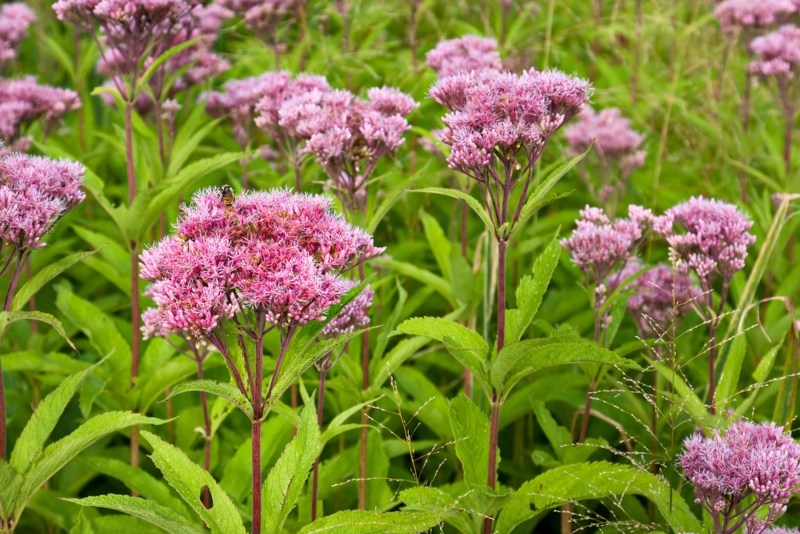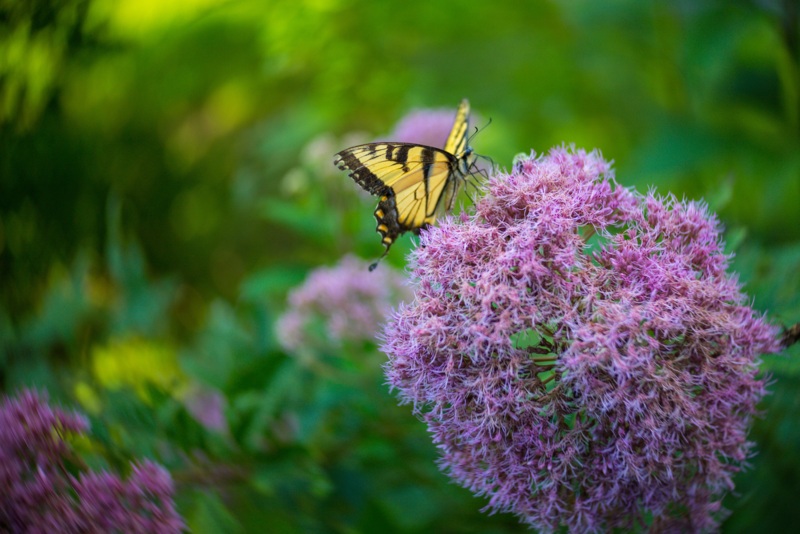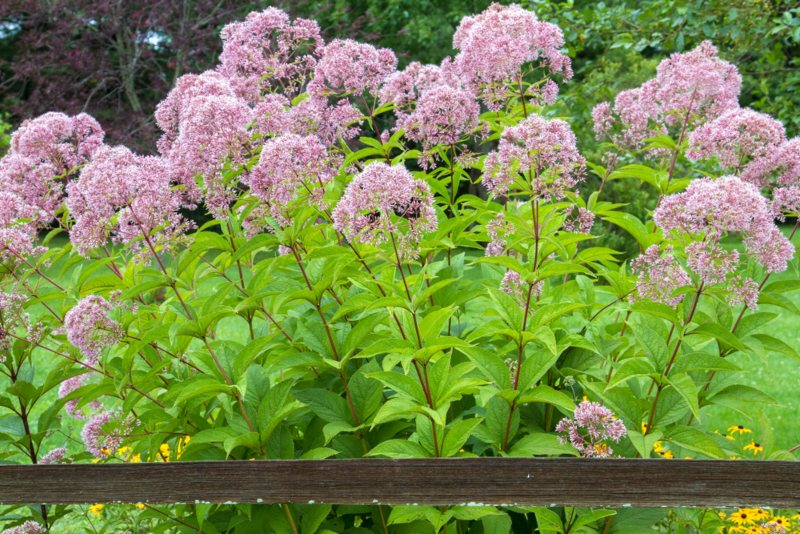
The Eutrochium genus is a large plant genus that contains flowers in the sunflower family. Depending on the species and their cultivar, these flowers have non-dissected foliage and pigmented flowers in various shades. The stems are thick and can reach up to be several feet tall. The flowers that bloom is mauve-pink and have a sweet scent.
While the Eutrochium genus doesn’t have many species within it, they are wonderful flowers for attracting butterflies. Their fast growth rate and low maintenance requirements also make them rewarding plants to grow for budding gardeners.
Joe Pye weed, also known as Eutrochium purpureum, is a wildflower originally from the central and eastern portions of North America. This origin is why this species is so hardy. Because this flower has to survive a wide range of temperature and soil conditions in this region of the world, Joe Pye weed has evolved to handle a wide swing in conditions.
This flower is typically grown outside, where it can be part of a butterfly garden or had some milder colors to accent stronger colors from other flowers nearby. It can be grown inside as long as the soil continues to stay moist and well-drained.
| Botanical Name: | Eutrochium purpureum |
| Common Name(s): | Joe Pye weed, gravel root, trumpet weed, kidney root |
| Plant Type: | Herbaceous, perennial |
| Mature Size: | 5-7 ft. tall, 2-4 ft. wide |
| Sun Exposure: | Full or partial |
| Water Needs: | Average |
| Soil Type: | Well-drained and moist |
| Soil pH: | Acidic, neutral, or alkaline |
| Bloom Time: | Summer |
| Maintenance: | Low |
| Flower Color: | Mauve pink |
| Hardiness Zones: | 4-9 (USDA) |
| Toxicity: | Non-toxic |
Joe Pye Weed Care
Because of their hardy nature, Joe Pye weed tends to be easy to take care of. Here are the various conditions you will want to meet to make sure your plant stays healthy and strong:
Light
Joe Pye weed does best when planted in either full sunlight or partial shade. Some sun is needed by the plant to keep its growth from stunting. Full, intense sunlight, like some areas of its native region get, can cause the leaves to yellow, so partial shade tends to be the most recommended condition for this plant.
A lack of sunlight can cause the plant to droop or become more susceptible to disease.
Water
Joe Pye weeds thrive in moist soil conditions. When first growing these plants, it’s best to keep the soil wetted but not soggy. This will give the plant the water it needs for its rapid growth rate. Once mature, water the plant so that the soil isn’t dry for more than a day or two.

Temperature/Humidity
Thanks to its native region, Joe Pye weed is a very hardy plant that is resistant to the cold and heart of its growing zones. Frost can cause the plant to die back into its winter hibernation state, while humidity tends to be a non-issue as long as the soil stays moist.
Soil
Joe Pye weed is flexible in its soil conditions. So long as the soil stays rich with nutrients and moist with water, then this plant can grow quickly. Clay soil doesn’t affect the growth of this plant much.
Once fully grown, Joe Pye weed is somewhat tolerant to droughts, so long as they aren’t extended for too long.
Fertilizer
If it’s growing in its native region, Joe Pye weed doesn’t generally need fertilizer. If you’re outside of the eastern or central parts of North America or the soil quality is poor, compost or slow-release fertilizer can encourage growth and bloom. It’s best to apply fertilizer at the beginning of growth and when blooms first appear.
Joe Pye Weed Toxicity
Unlike some of its relatives in the same genus, Joe Pye weed is non-toxic to both humans and animals. The flowers are great for attracting butterflies thanks to the vanilla scent of the blooms, making this flower great for bringing friendly insects to your garden.
Other members of the genus, such as white snakeroot, can be poisonous to humans and animals, though.

Potting and Repotting Joe Pye Weed
Because of the size of the plant, Joe Pye weed doesn’t do well in a pot for the duration of its life. However, it’s possible to start off growing this plant in a pot first and then transfer them into your garden later.
Plant the seeds in cold soil about four to six weeks after your average last frost date. Once the plant begins to sprout and grow, transfer the plant out of the pot by carefully digging up both the stem and roots. Place the sprout into the soil and water as needed to keep the area moist.
Propagating Joe Pye Weed
The best way to propagate Joe Pye weed is via division. With a sharp shovel, split one stem from the rest of the plant and dig it up with the root. From there, the plant can be replanted into another pot or spot in your garden. Make sure you plant the separated stem at the same soil depth it was at before.




